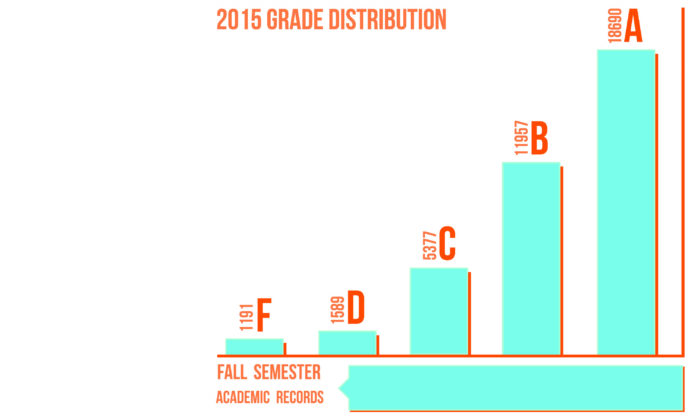During the fall 2015 semester, Slippery Rock University students earned a grand total of 18,690 A’s, which has been a common trend at the university for several years.
There were a total of 41,238 grades awarded during the fall semester, where 45.32 percent of that total were A’s. There was a total of 11,957 B’s, 5,377 C’s, 1,589 D’s and 1,191 F’s. The remaining 2,434 grades reflect incompletes, no credits, passes and withdraws.
Eliott Baker, executive director of academic records and summer school, explained that the grade distribution reflects both undergraduate students and graduate students, as the office does not collect that data separately. He said that on average most graduate students are earning all A’s and B’s because those students already have a degree and are more serious, as well as the fact that they have to maintain a minimum of a 3.0 GPA to avoid academic probation.
He explained that it is more accurate to look at the breakdown of cumulative QPAs between freshmen, sophomores, juniors and seniors.
Baker said that after the fall semester, freshmen males averaged a cumulative QPA of 2.719 and freshmen females averaged a cumulative QPA of 3.007, with an average total of a 2.880 cumulative QPA between the genders.
“The same students had supposedly a 3.4 high school grade point average, so you can say well ‘grades are increasing’, but if our average freshman had a 3.4 grade point average in high school and at the end of their first semester, they have a 2.88, you get a sense of perhaps, how more rigorous the grading in college is,” he noted. “Now is there grade inflation in high school? I don’t know.”
Sophomore males earned an average cumulative QPA of 2.880, while sophomore females earned an average cumulative QPA of 3.174, averaging a total of 3.041 between the genders.
Baker explained that as a student continues their studies at SRU, academic records often sees that QPAs increase, as male juniors earned an average QPA of 2.968, female juniors earned an average QPA of 3.244, male seniors earned an average QPA of 3.087 and female seniors earned an average QPA of 3.384.
However, Baker explained that the data reflects that not even average seniors at SRU are earning the average 3.4 QPA that they used to in high school.
“There’s a multitude of different theories,” Baker said, noting the high A trend at SRU. “There’s one theory that says professors are easier.”
Associate professor in special education and department chair Joseph Merhaut graduated from SRU in 1989 with a degree in special education.
Merhaut said he believes that the high A count reflects the fact that the university offers outstanding professors and recruits higher achieving students.
“Earning A’s in college is as feasible as the student wants it to be,” he said. “Students who are organized, study everyday and prepare well for tests can earn all A’s. It is highly unlikely that many students will earn all A’s though.”
Merhaut said that when he attended SRU, he earned a QPA of a 3.1, but did well in his major courses.
As for grading his students, Merhaut said that he uses a 90, 80, 70 and 60 percent scale for quizzes and tests. He said he also provides his students with rubrics for projects, so his expectations are clearly understood.
“Many students earn A’s in my classes, but you have to keep in mind that these classes are in their major so their interest level is very high,” he explained. “I have given the entire gamut of grades however.”
Mark Shotwell, associate professor of biology, said that he has been tracking the relationship between grades and QPAs since 1997.
“For example, the average cumulative QPA was 2.835 in 1997,” he said. “It was 3.077 in 2.15, Based off of qualifications of entering freshmen have increased over that time, but in my opinion, [it’s] not enough to explain the more than 0.2 increase in average QPA.”
He said he believes that there is a better faculty at the university now, but he doesn’t think that fully explains the increase. He said it is possible that some professors may have lower expectations than other professors, as tenure is an incentive.
“It is also the case that grade inflation has occurred at colleges and universities across the country, so something is going on across the country,” Shotwell said.
Shotwell said his standards as a biology professor are high, but that it is not impossible for his students to earn A’s in his classes.









Grade inflation???